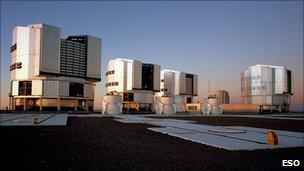Exploding star 'viewed in 3D'
- Published
This video zoom shows images of SN1987A from ESO telescopes, ending with an artist's impression of a close-up of the exploding star.
Astronomers have for the first time obtained a 3D view of the aftermath of a star exploding (which is known as a supernova).
The team used the Very Large Telescope in Chile to study the supernova 1987A, which lies 168,000 light-years away.
The results show the original blast was very powerful and concentrated in one particular direction.
Seen in 1987, it was the first supernova visible with the naked eye to have been observed for some 383 years.
The 3D view shows the explosion was stronger and faster in some directions than others, leading to an irregular shape with some parts stretching further out into space.
This phenomenon was predicted by some of the most recent computer models of supernovae, which found that large-scale instabilities take place during the explosion.

Europe's VLT facility is sited in Chile
The observations of SN 1987A were made using the SINFONI instrument on the European Southern Observatory's (ESO) Very Large Telescope (VLT) in Chile.
The first material to be ejected from the explosion travelled at 100 million km per hour, which is about 100,000 times faster than a passenger jet.
Even at this incredible speed it has taken 10 years to reach a previously existing ring of gas and dust puffed out by the star while it was dying.
The images also show another wave of material is travelling 10 times more slowly and is being heated by radioactive elements created in the explosion.
The research is to be published in the academic journal Astronomy and Astrophysics.